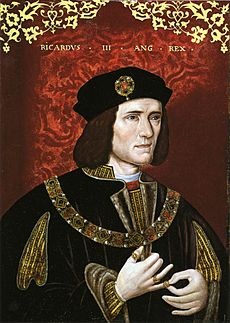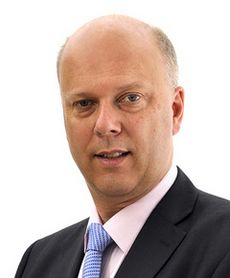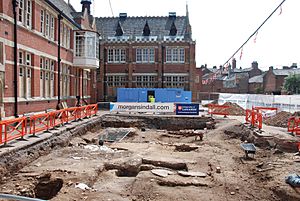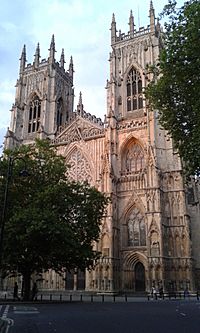Plantagenet Alliance facts for kids

The Plantagenet Alliance was a small group of people who believed they were related to Richard III. He was the last king of England from the Plantagenet family, and he died in 1485. The Alliance formed in 2013 after Richard III's remains were found and identified. Their main goal was to decide where Richard III should be reburied.
The group wanted Richard III to be buried at York Minster. They felt that, as his distant relatives, they knew what he would have wanted. They even called themselves "his Majesty's representatives and voice." However, many historians disagreed, saying there was no proof Richard III wanted to be buried in York. Also, Richard III would have had millions of other distant relatives, and the Alliance didn't speak for all of them.
The Plantagenet Alliance even took legal action in 2013 and 2014. They challenged the decision to rebury Richard in Leicester. But the Alliance lost their court case in 2014. Their campaign to have Richard buried in York failed. The group hasn't been active in public since then. Richard III's remains were finally reburied inside Leicester Cathedral on March 26, 2015.
Contents
Finding Richard III's Remains
In September 2012, a team of archaeologists from the University of Leicester made an amazing discovery. They found the remains of Richard III buried under a car park in Leicester. Richard III had died in 1485 at the Battle of Bosworth Field.
In February 2013, the government's Ministry of Justice announced something important. They said the University of Leicester had the right to decide where Richard III would be reburied. This was part of the agreement for digging up his remains. The University of Leicester then confirmed their plan. They had always intended for Richard's remains to be reburied in Leicester Cathedral.
Forming the Plantagenet Alliance
The Plantagenet Alliance was started shortly after Richard III's remains were confirmed. Stephen Nicolay, who is a distant relative of Richard III's sister, helped create the group. He formed it with other "collateral descendants." This means they were related to Richard III through his siblings, not directly through his children. Their main goal was to have Richard buried at York Minster.
Another member, Vanessa Roe, shared her story. She said the Alliance began after she contacted York City Council. She had seen a TV show about Richard III's discovery. The council then connected her with other people who also claimed to be related to the king.
Who Were the Members?
The Plantagenet Alliance was made up of people who believed they were distant relatives of Richard III. They claimed to be his 16th, 17th, or 18th great-nieces and great-nephews. The group chose their name from the House of Plantagenet. This was the royal family that Richard III belonged to. He was the last Plantagenet king.
In March 2013, reports said there were about fifteen members. By December 2013, the number grew to around forty. The full group has never met in person.
Some well-known members included Stephen Nicolay, Vanessa Roe, and Charles Brunner. Stephen Nicolay is a gardener. He is a 16th great-nephew of Richard through his sister, Anne of York. He only found out about his royal connection in 2011.
Vanessa Roe runs a small farm near York. She works with young people who have disabilities. She is a 16th great-niece of Richard III. She is related through Richard's brother, George, Duke of Clarence. Vanessa Roe was often called the "group's spokesperson." Charles Brunner is from America and owns a nightclub. He is a 17th great-nephew of the king, also related through Anne of York. He was described as "one of the leaders" of the Alliance.
What the Alliance Believed
In February 2013, the Plantagenet Alliance made a public statement about Richard III's burial place. They respectfully demanded that Richard III's remains be returned to York for reburial. They believed this was what King Richard wanted when he was alive.
The group claimed to speak for Richard III. They felt they knew his wishes because of their family connection. They said they were "his Majesty's representatives and voice." Vanessa Roe explained their strong feelings: "We are the collateral [non-direct] descendants of Richard III, we speak on behalf of him... Many of us have grown up knowing about Richard, we know what he wanted."
The Alliance argued that Richard wished to be buried in York. They pointed to his strong ties with Yorkshire. He grew up there, was known as "Richard of York," and visited York often as king.
Their Campaign Efforts
The Plantagenet Alliance tried different ways to achieve their goal.
Online Petition
In 2013, the Alliance started an online petition with the UK government. They hoped to get support for burying Richard in York. If a petition gets 100,000 signatures, it can be discussed in Parliament. However, their petition closed on September 24, 2013, with only 31,276 signatures. It did not reach the goal.
Taking Legal Action
In 2013, the Plantagenet Alliance decided to take the government to court. They started a judicial review case. They argued that they, as Richard's relatives, should have been asked about his burial place. They felt their human rights had been ignored.

The Ministry of Justice had given permission for Richard's remains to be reburied in Leicester. The Alliance claimed that not asking them about this decision went against their rights. Chris Grayling, who was the Justice Secretary at the time, disagreed. He said the claim was "nonsensical."
The Alliance's lawyers worked on a special agreement. They would only get paid if they won the case. This meant the Alliance wouldn't have to pay the government's legal costs if they lost.
In August 2013, a judge allowed the Alliance to continue with their case. The judge also made a special order. This order meant the Alliance would not have to pay the Ministry's legal costs, even if they lost. The judge explained that such orders are sometimes given when a case is important for the public to hear.
The court case was heard by three High Court judges in May 2014. The judges ruled in favor of the Ministry of Justice. They said there was no reason to expect Richard's distant relatives to be consulted after so many centuries. They also pointed out that Richard could have millions of distant relatives, so consulting everyone would be impossible.
After the decision, Vanessa Roe felt there was "no justice" for Richard III. Chris Grayling, the Justice Secretary, criticized the Alliance for bringing the case. He called them "a group with tenuous claims to being relatives of Richard III." He was "frustrated and angry" that the case had "taken up so much time and public money." He said it was an example of how the legal system was being misused. The legal costs for the government and Leicester City Council were around £175,000. The total cost to taxpayers was estimated to be over £200,000.
Historians' Views
Historians generally agreed that there was no proof Richard III wanted to be buried in York. Mark Ormrod, a historian from the University of York, doubted that Richard had made any clear plans for his own burial.
Also, the idea that the Plantagenet Alliance truly represented Richard's wishes was questioned. A mathematician named Rob Eastaway calculated that Richard III might have millions of living distant relatives. He joked that "we should all have the chance to vote on Leicester versus York."
Richard's Reburial in Leicester
Plans for Richard III's reburial had been paused while the court case was ongoing. The Dean of Leicester Cathedral had called the Alliance's challenge "disrespectful." He said the cathedral would not spend money on the reburial until the legal matter was settled.
Once the High Court made its decision in May 2014, the Bishop of Leicester, Tim Stevens, announced the reburial would go ahead. Richard III was finally reburied at Leicester Cathedral on March 26, 2015.
See also




